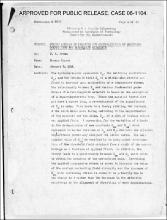Stress Effects in Ferrites and Generalization of Switching Coefficient for Non-square Materials
Menyuk, Norman

DownloadMC665_r13_M-2602.pdf (4.210Mb)
Date
1954-01-06Abstract
The hysteresis-loop squareness R[subscript s], the switching coefficient S[subscript W], and the threshold field H[subscript o] of a nickel-zinc ferrite are found to increase upon application of a compressive stress. The relationship between S[subscript w] and various fundamental parameters of a ferromagnetic material is based on the assumption of a square-hysteresis loop. Since the material tested does not have a square loop, a re-evaluation of the significance of S[subscript w] is made. This leads to a theory relating the distance d the Block walls move during switching to the magnetization of the material and the slope, S[subscript v], of a plot of voltage output vs. applied field. A correction for the variation of d leads to the determination of new constants S[subscript wm] and H[subscript om] which represent corrected versions of S[subscript w] and H[subscript o], and have the physical significance previously assigned the latter terms. The calculated value of H[subscript om] is verified by an independent determination of the threshold field obtained from a study of the output voltage as a function of applied field. In addition, the theory leads to a relationship between S[subscript wm] and S[subscript v] which holds to within the accuracy of the assumptions made. Increasing the applied compressive stress is show to increase the value of the maximum nucleating field strength, and the increase of S[subscript wm] with increasing stress is shown to be primarily due to the change in d rather than the increase in the effective anisotropy or the alignment of directions of easy magnetization.